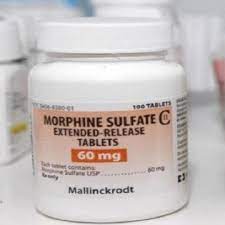Morphine Sulfate: Classification, Uses, and Key Information
Morphine sulfate is a potent opioid analgesic prescribed for the relief of moderate to severe pain that cannot be managed with non-opioid medicines. As a Schedule II controlled substance, morphine sulfate has a high potential for misuse, dependence, and addiction, which is why it must only be used under strict medical supervision.

morphine sulfate
Morphine Sulfate Classification
Morphine sulfate belongs to the opioid agonist classification, directly derived from the opium poppy plant. It works by binding to mu-opioid receptors in the central nervous system, altering pain perception. Due to its narcotic properties, morphine sulfate is tightly regulated and classified as Schedule II under the DEA Controlled Substances Act, meaning it has accepted medical use but also a high risk of abuse.
Morphine Sulfate Brand Name and Forms
Morphine sulfate is available under different brand names, such as MS Contin, Kadian, Roxanol, Avinza, and Duramorph. These formulations are used in hospitals, hospice care, and outpatient pain management. Common forms include:
Liquid morphine sulfate – Oral solution for patients who cannot swallow tablets.
Morphine sulfate ER (extended-release tablets) – For long-term, around-the-clock pain relief.
Morphine sulfate plain – Standard formulation without additives.
Injectable morphine sulfate – Used in emergency and surgical settings.
Morphine sulfate 5 mg/0.25 mL – Precise dosing option for sensitive patients.
Morphine Sulfate Mechanism of Action
The mechanism of action of morphine sulfate involves activation of opioid receptors in the brain and spinal cord. This suppresses the transmission of pain signals, leading to:
Effective pain relief
Sedation and relaxation
Reduction of emotional stress associated with pain
Because of its powerful effects, morphine sulfate is used for chronic cancer pain, post-surgical pain, and in some cases, chest pain management.
Morphine Sulfate Dosage and Administration
The morphine sulfate dosage depends on a patient’s pain severity, medical history, and tolerance:
Morphine sulfate 5 mg/0.25 mL oral solution – for small, precise dosing.
Extended-release tablets (morphine sulfate ER) – available in 15 mg, 30 mg, 60 mg, and 100 mg strengths.
Injectable morphine sulfate – provides rapid relief in hospital emergencies.
Morphine sulfate for chest pain – sometimes used in acute cardiac care under doctor supervision.
⚠️ Important: Dosing should never be adjusted without medical approval due to the risk of overdose.
Morphine Sulfate Side Effects
Like other opioids, morphine sulfate side effects may occur. Common ones include:
Drowsiness, dizziness, and sedation
Nausea, vomiting, and constipation
Sweating or itching
Blurred vision and dry mouth
Serious risks:
Life-threatening respiratory depression
Low blood pressure
Dependence, tolerance, and withdrawal symptoms
Overdose risk if misused
Always follow the morphine sulfate medication template provided by your doctor or pharmacist.
Morphine Sulfate Safety, Storage, and Patient Guidance
Storage: Keep morphine sulfate in a locked, childproof container at room temperature. Do not share with others.
Missed Dose: Take as soon as remembered, but skip if close to the next scheduled dose. Do not double up.
Overdose Warning: Symptoms include slowed breathing, extreme drowsiness, cold/clammy skin, or loss of consciousness. Seek emergency help immediately.
Avoid Alcohol and Sedatives: Combining morphine sulfate with alcohol or CNS depressants increases the risk of fatal respiratory depression.
High Risk Patients: Those with lung disease, asthma, head injuries, or history of substance misuse must consult a doctor before use.
Conclusion
Morphine sulfate is a powerful opioid pain reliever that provides effective treatment for severe, chronic, and breakthrough pain. With multiple forms including liquid morphine sulfate, morphine sulfate ER, and injectable formulations, it remains a cornerstone in pain management. However, as a Schedule II controlled medication, it carries significant risks of addiction, misuse, and overdose.
For safe use, patients must follow prescribed morphine sulfate dosage instructions, monitor side effects, and store it securely. Always consult a healthcare professional before starting or adjusting morphine sulfate treatment.
Morphine Sulfate FAQ
1. What is morphine sulfate for?
Morphine sulfate is prescribed to treat moderate to severe pain, especially when other pain medications are not effective. It is commonly used in post-surgical care, cancer pain, and hospice treatment.
2. Is morphine sulfate the same as oxycodone?
No, morphine sulfate and oxycodone are different opioid medications, but both belong to the opioid agonist classification. Morphine sulfate is derived from the opium poppy, while oxycodone is a semi-synthetic opioid. Their effectiveness may vary depending on the patient’s pain type and tolerance.
3. What does morphine sulfate make you feel like?
Morphine sulfate may cause pain relief, relaxation, and drowsiness. Some patients experience a sense of calm or mild euphoria, while others may feel sleepy or dizzy. Because of these effects, it should only be taken as prescribed to reduce risks of misuse.
4. What is the difference between morphine and morphine sulfate?
There is no difference in terms of active ingredient. The term morphine sulfate simply refers to the sulfate salt form of morphine, which is used in medications for easier absorption and stability.
5. Is morphine sulfate a strong painkiller?
Yes, morphine sulfate is considered a strong opioid painkiller. It is more potent than many standard pain relievers and is reserved for moderate to severe pain that cannot be managed with non-opioids.
6. Does morphine sulfate make you sleep?
Yes, drowsiness and sleepiness are common side effects of morphine sulfate. Some patients may even experience deep sedation, especially at higher doses or when starting treatment.
7. What is stronger, morphine sulfate or hydrocodone?
Both are opioid medications, but morphine sulfate is generally stronger and more effective for severe pain. Hydrocodone is usually prescribed for moderate pain, often in combination with acetaminophen.
8. What happens when hospice starts morphine sulfate?
When given in hospice care, morphine sulfate is used to ease pain and shortness of breath. It helps improve patient comfort during end-of-life care, not to hasten death.
9. Is morphine sulfate immediate release?
Yes, morphine sulfate is available in immediate-release (IR) tablets as well as extended-release (ER) formulations. Immediate-release forms act quickly for short-term pain relief, while ER tablets provide long-lasting control.
10. What’s stronger than morphine sulfate for pain?
Certain opioids are stronger than morphine sulfate, including fentanyl, hydromorphone (Dilaudid), and oxymorphone. These are typically used in hospital or palliative care settings for severe, breakthrough pain.












Reviews
There are no reviews yet.